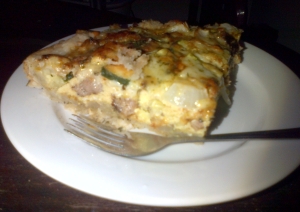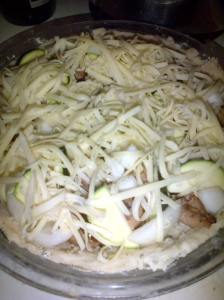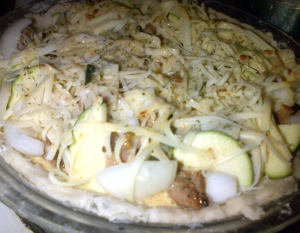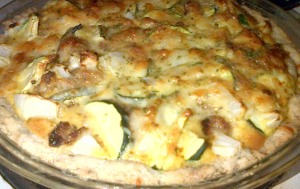When I was in university, I made my first vegetarian friends — and I had no idea how to feed them. My high-school girlfriend’s brief flirtation with vegetarianism had consisted mostly of grocery-store-brand veggie lasagna, vegetarian chili-cheese fries at the cafeteria, and eating a lot of raw veggies & dip. I’d never had to cook an entrée that didn’t include meat, before, and wasn’t entirely sure where to begin.
A search online for vegetarian recipe ideas led me to a food I’d never tried before: quiche. I figured that something which looked essentially like an omelette in a pie crust couldn’t possibly be half bad, and whipped up a quick version with broccoli, mushrooms, and three kinds of cheese. It was a success, and quiche entered my cooking arsenal as an easy, quick, and crowd-pleasing piece of comfort food.
These days, while quiche remains an easy default for vegetarian-friendly meals, it’s something I make more often as a portable lunch-option for work, or as something I can quickly reheat when I’m too busy to cook for a few days. It’s also a great way of using up leftovers, since you can throw pretty much anything into a quiche and it’ll come out tasting pretty good. I usually do, in fact, use meat in my quiches — today’s version includes pork sausage — but they’re an incredibly flexible food that you can easily tailor to your particular desires.
The Crust
The most labour-intensive part of a quiche is the crust. I generally use my basic pie crust recipe as the starting point, but since a quiche doesn’t require a top crust I’ll just whip up a half-sized batch.
Cut a half-cup of vegetable shortening into 1-1/3 cups all-purpose flour and a pinch of salt, until you’ve got a crumbly mixture with no big clumps of shortening. At this point, since quiche is a savoury dish, you may want to add a few herbs — I like to toss in a sprinkling of dried Italian herbs for visual interest and a bit of a flavour-hit in the crust. Sprinkle cold water in, a tablespoon at a time, until the dough just comes together into a slightly-crumbly ball. Refrigerate the dough for 15 minutes or so before rolling out into the bottom of your pie dish (or a round cake pan will do, if you want a deeper quiche with a more straight up-and-down edge — a springform pan will allow you to make a deep-dish quiche without the difficulty of removing it at the end).
Alternatively, you can either use a store-bought crust, or puff pastry. Either is perfectly acceptable (although everyone should really make a scratch-made crust at some point in their life).
The Filling
As I’ve already mentioned, you can put pretty much anything you like into a quiche. Meat should be pre-cooked (for today’s quiche, I browned the sausage & some onions in a frying pan for the filling), but vegetables can be either cooked or raw — I tend to prefer raw veggies, since they retain more of their individual flavour and texture within the cooked quiche. Frozen veggies are perfectly acceptable, here — just give them a rinse to get rid of the “freezer taste”. Dark green veggies like broccoli, asparagus, and spinach are classic quiche ingredients, but don’t feel limited; use whatever you like.
Leftovers are a great option for quiche, so this is the perfect place to use up the last bits from your roast or chicken dinner.
Depending on the texture you prefer, you can use large or small pieces in your filling. I like the texture & flavour variations provided by using larger pieces of veggies, but it’s entirely up to you. Smaller bits will give a more uniform flavour throughout the dish.
Where I differ from many classic quiche recipes is that I like there to be a LOT of stuff in my quiche. While custard is delicious, I prefer to add just barely enough egg & cream to hold the whole thing together, to make a more hearty meal. So as you can see in the photo, I fill my dish right up. Meat, veggies, and plenty of cheese, with just a few little spaces in-between for the egg to fill. Putting the majority of the cheese on top (use any kind you like; my quiche today has a combination of Parmesan and sharp Cheddar) makes for a nice toasted, crispy top that both looks and tastes delightful.
The Custard
The defining ingredient of quiche is, of course, the custard. Thoroughly beating the eggs is important to getting a nice, fluffy texture on your finished product. For my 9″ pie pan, I use 3 eggs and about a cup of cream (5-10%, although whole milk will do if you’re concerned about fat content). Add your herbs & spices to your custard — salt, pepper, garlic powder, and paprika (be generous with the paprika) are my usual “basic” mix, and then I’ll add other spices to compliment whatever filling I’m using. Chili spice or cayenne for a spicier meal, parsley & sage to go with chicken, rosemary with beef, dill & thyme with fish — or, like today, a generous scoop of curry powder to compliment my pork sausage. Make sure the herbs & spices are thoroughly mixed in, then pour your custard mix slowly over top of the filling in the pie shell. A few light taps on the side of the pie pan will make sure that the custard has filled up all the holes between the filling.
Note that your quiche should not look particularly “full” of custard at this point. It will puff up during cooking — if the pie pan is full to the brim, you’ll get spillover as things cook. You can see in the pictures that mine looks quite “shy” before going in the oven, but once things are cooked the eggs have puffed up to fill the remaining space.
Cooking, Serving, Storing, and Re-Heating
In an oven heated to 375 Fahrenheit, bake your quiche for about 40 minutes (until the crust is golden-brown). Once you take it out, let it sit for 5 minutes or so before serving — this will let the custard solidify a bit more, and make it easier to slice & serve.
I like my quiche with a bit of hot sauce on top, or occasionally a drizzle of balsamic vinegar. If you’re feeling decadent, you can drizzle on a bit of hollandaise. A 9″ pie pan makes about 4 servings. A bit of salad on the side rounds out the meal, but certainly isn’t necessary.
Quiche will keep wonderfully for 3-4 days in the fridge — wrap tightly with plastic wrap or aluminum foil, or store in an airtight container, to prevent it from drying out. Or you can divide it into portions & freeze for 2-3 months.
Reheating is best done in an oven or toaster oven, to maintain the crisp & flaky crust. If you’ve frozen your quiche, reheat it directly from frozen, don’t thaw it out first. If you’ve just been keeping it in the fridge, it should only take about 10 minutes to be heated through & ready to eat.
Microwaving is faster, but your crust will get soggy. 3-5 minutes should do, depending on your particular microwave.
You can also eat quiche without reheating, which is often what I’ll do at lunch time.







